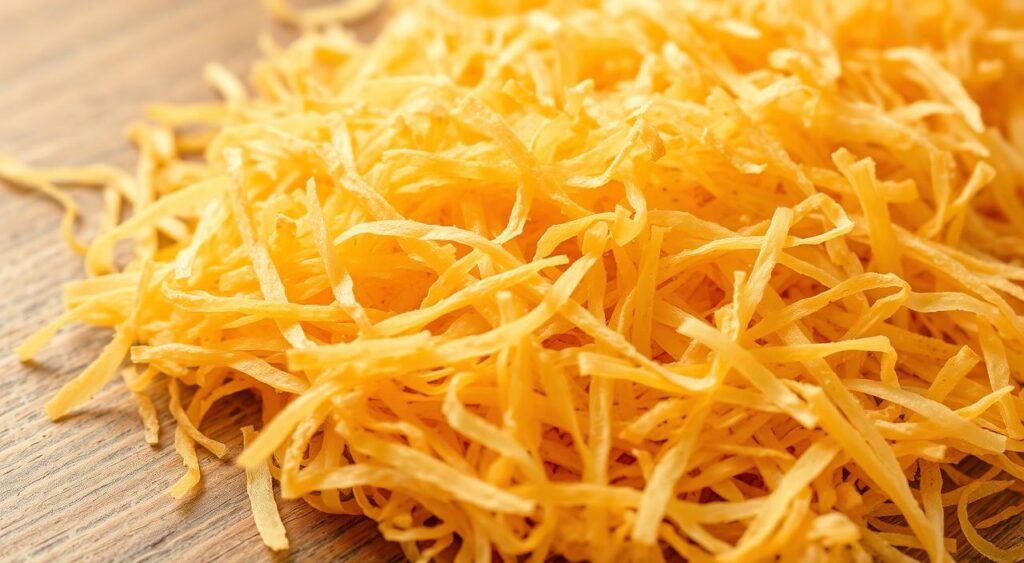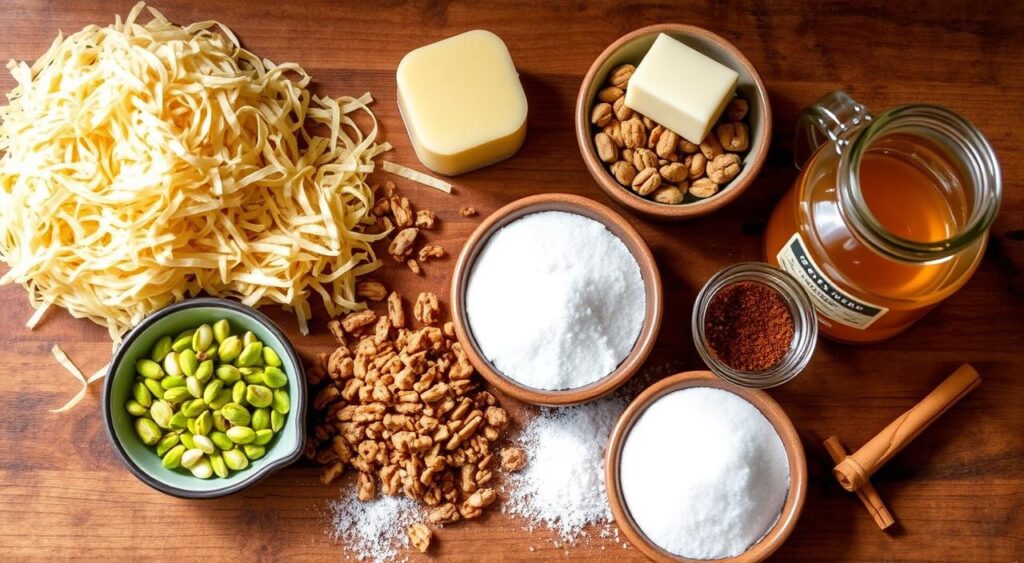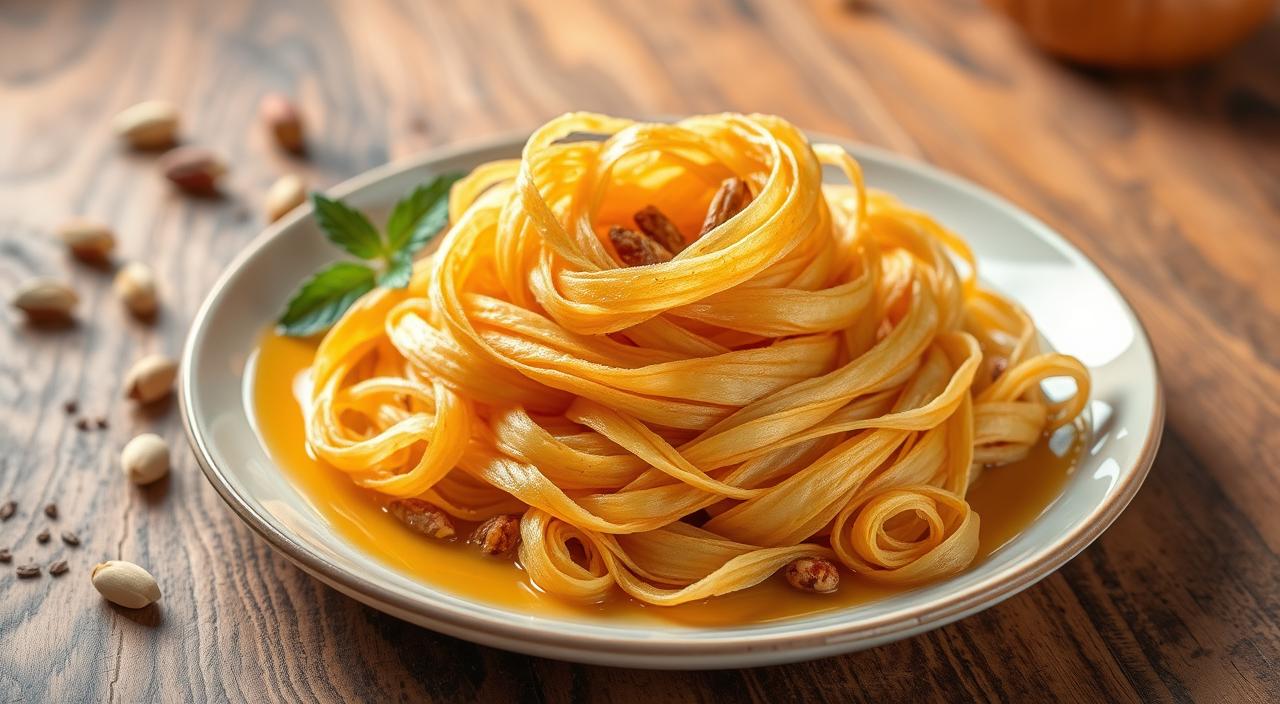I love baking at home and always wanted to try kataifi pastry. It’s a shredded phyllo dough from the Middle East. It makes simple desserts into amazing dishes. You can make many things with it, like kunafa and baklava.
My neighbor first introduced me to homemade kataifi. The smell of it baking was incredible. The golden strands and sweet syrup were amazing. After trying it, I wanted to learn how to make it myself.
In this guide, I’ll teach you how to make perfect kataifi pastry at home. It doesn’t matter if you’re experienced or new to baking. You’ll learn how to make this tasty treat in your kitchen. Let’s start and explore the world of Middle Eastern pastry!
Understanding Kataifi Pastry and Its Origins

Kataifi pastry is known as Turkish kunefe or Arabic knafeh. It’s a special type of shredded filo pastry. It’s used in Middle Eastern, Mediterranean, and Balkan cuisines. Unlike regular phyllo dough, kataifi is made into fine, thread-like strands. This gives it a crispy and delicate texture.
Traditional Uses in Middle Eastern Cuisine
In the Middle East, kataifi dough is a key ingredient in desserts like kunafa and baklava. Its shredded texture holds cultural importance. You can find variations in countries like Greece, Turkey, and many Middle Eastern nations.
Cultural Significance Across Mediterranean Regions
The origins of kataifi pastry are a topic of debate. Some think it might have started in Egypt, during a religious festival to feed people. But, it’s definitely a big part of Greek cuisine. It’s used in desserts like Kataifi Pastry, Kataifi with Caramel, and Ek Mek Kataifi.
Difference Between Phyllo and Kataifi
Phyllo and kataifi are both thin, flaky pastry doughs. But, they’re made differently. Phyllo is made into thin sheets. Kataifi is spun into fine, shredded strands. This makes kataifi crispy and delicate.
Essential Ingredients for Homemade Kataifi Pastry

Making authentic kataifi pastry at home is simple yet precise. You need all-purpose flour, cornstarch, and sea salt as the base. These dry ingredients are mixed with vegetable oil and water to create the dough.
The quality of your ingredients, especially flour and oil, matters a lot. They affect the texture and taste of your syrupy dessert. Using fresh, high-quality ingredients will help you bring traditional kataifi pastry flavors to your kitchen.
“The quality of ingredients, especially the flour and oil, is crucial in achieving the perfect kataifi pastry at home.”
To make the dough, you’ll need 450g of all-purpose flour, 30g of cornstarch, and a pinch of sea salt. You’ll also need 250ml of vegetable oil and 330ml of water. These ingredients, when mixed and shredded, will be the base of your homemade kataifi pastry.
With these ingredients, you’re ready to make a delicious buttery phyllo strands and syrupy dessert in your kitchen.
Required Kitchen Tools and Equipment
To make delicious kataifi pastry at home, you need some special tools. A big flat pan or skillet is key for shredding the dough. Also, a squeeze bottle with a small hole is vital for spreading the dough evenly.
You’ll also need a whisk, a fine-mesh strainer, and several bowls. These are for mixing the batter and handling the shredded dough.
Specialized Tools for Perfect Results
The squeeze bottle with a small hole is crucial for getting the right strands. It lets you control the dough flow and shape as you shred it. Without it, shredding the dough can be harder and slower.
Alternative Equipment Options
If you don’t have a squeeze bottle, a piping bag with a small tip works too. It’s not as precise, but with practice, it can still give good results.
Preparation Setup Guide
Before making kataifi pastry, set up a clean, big work area. Make sure all ingredients are measured and ready. Also, preheat the pan to the right temperature. This setup helps you control the process and get the best results.
Preparing the Perfect Kataifi Batter
Making the perfect kataifi, a favorite Middle Eastern pastry, starts with a flawless batter. This delicate, shredded baked dessert needs a specific mix to get its fine strands right.
Begin by mixing flour, cornstarch, and sea salt in a bowl. Slowly add oil and water, whisking until it’s smooth and without lumps. Strain the batter through a sieve to make it silky-smooth and ready for the kataifi threads.
The batter’s consistency is key – it should be thin but still hold its shape. This balance is what makes the kataifi’s texture so special.
“Achieving the right batter consistency is the foundation for creating the characteristic fine strands of kataifi pastry.”
With the batter ready, you’re almost there. Next, we’ll look at the shredding technique that makes this Middle Eastern treat come alive.
Mastering the Shredding Technique
To make perfect Turkish kunefe or shredded filo pastry at home, you need to get good at shredding the batter. This means squeezing the mix through a small hole in a circular motion. Start from the center of a hot pan and move outwards.
It’s important to keep your hand steady and apply even pressure. This helps make thin, even strands.
Proper Motion and Speed Control
Start by heating the pan over medium heat. Then, use your fingers to push the batter through the hole in a circular motion. Keep the pressure gentle but steady.
Adjust how fast you move your fingers to get the right thickness. If you’re too fast, the strands won’t be even. If you’re too slow, they might stick together.
Troubleshooting Common Issues
If your shredded filo pastry strands are too thick, try making the hole a bit bigger. If they’re not even, focus on moving smoothly and consistently.
Also, watch the pan’s temperature. If the pastry browns too fast, the heat is too high. Turn down the heat to get the right golden color.
“The key to mastering the shredding technique is patience and practice. Take your time, experiment with the speed and pressure, and don’t be afraid to make adjustments until you find the perfect balance.”
With a little practice, you’ll be making Turkish kunefe like a pro. You’ll get delicate, even strands that make a delicious Middle Eastern dessert.
Working with Kataifi Pastry
After making your Arabic knafeh, it’s time to work with the buttery phyllo strands. Be gentle with the kataifi to keep its shredded texture. When making desserts, layer it with melted butter for a crispy, rich taste.
Kataifi is great for making nests, rolls, or layers. Work fast to avoid drying out the pastry. Keep unused parts covered with a damp towel. Soon, you’ll be a pro at shaping and layering kataifi.
“The key to working with kataifi is patience and a gentle touch. Take your time to layer it properly, and you’ll be rewarded with a truly show-stopping dessert.”
Be careful with kataifi since it’s delicate. Follow these tips to make stunning Middle Eastern treats at home. You can try traditional Arabic knafeh or new recipes with kataifi. The possibilities are endless.
Storage and Handling Tips
Storing and handling kataifi pastry right is key to keeping its texture and taste. Whether you buy it or make it yourself, these tips will help. Your syrupy desserts and Palestinian knafeh will stay fresh and tasty.
Freezing Guidelines
Kataifi pastry can be frozen for long-term storage. It’s usually found or stored in the freezer. To thaw, put it in the fridge overnight, not at room temperature, to avoid sogginess. Use it right after thawing.
If you made kataifi at home, let it cool completely before freezing. Store it in an airtight container. It can last months in the freezer.
Thawing Methods
Kataifi pastry takes about 2 hours to thaw at room temperature. For better results, thaw it in the fridge overnight. This slow thaw keeps the pastry’s delicate texture.
After thawing, handle the kataifi gently to avoid drying or softening. Cover it with a damp towel or plastic wrap. This keeps it moist until you’re ready to use it.
“Frozen kataifi can be a lifesaver when you’re craving a taste of the Middle East. Just be sure to thaw it properly to enjoy the perfect texture.”
Common Mistakes to Avoid
Making perfect kataifi pastry at home needs care and precision. Steer clear of common mistakes that can ruin its delicate texture and taste. Using a squeeze bottle with a hole that’s too big can make the pastry strands thick and uneven. To get thin, uniform threads, shred the dough in a steady circular motion.
Another mistake is letting the kataifi pastry dry out. Keep it covered and moist to prevent it from becoming hard. Not using enough butter when making desserts can also lead to poor results. The butter is key for the pastry’s flaky and crispy texture.
Don’t pour hot syrup over hot pastries, as it can make them soggy. Always use cold syrup on warm pastry for the best texture. Lastly, avoid overworking the dough. It should be handled gently to achieve the best taste.
By avoiding these common mistakes, you’ll get better at making kataifi pastry. You’ll be able to create delicious Middle Eastern dishes in your kitchen.
Traditional Recipes Using Kataifi Pastry
Kataifi pastry, also known as Turkish kunefe or Arabic knafeh, is a versatile ingredient. It’s used in many traditional Middle Eastern and Mediterranean desserts. Two classic recipes that highlight its unique texture and flavor are kunefe and baklava.
Classic Kunefe Recipe
Kunefe is a beloved syrupy dessert. It’s made with layers of kataifi pastry, gooey cheese, and fragrant syrup. Start by buttering a baking dish and layering the bottom with shredded kataifi pastry.
Top it with a generous amount of cheese, like Akkawi, Nabulsi, or a mix of mozzarella and ricotta. Cover with more kataifi pastry and bake until golden brown. Then, soak the hot kunefe in a fragrant sugar syrup, with rosewater or orange blossom water for an authentic taste.
Baklava Variations
Kataifi pastry is also great for making mouthwatering baklava. Instead of traditional phyllo dough, layer the shredded kataifi with chopped nuts and warm spices. Use pistachios, walnuts, or almonds, and spices like cinnamon, cloves, and cardamom.
Bake the baklava until the pastry is crisp and golden. Then, drizzle with a spiced honey syrup for an indulgent dessert.
These traditional recipes show how versatile and unique kataifi pastry is. Whether you love the syrupy delight of kunefe or the nutty richness of baklava, using this pastry will take your desserts to the Middle East and Mediterranean.
Tips for Achieving Perfect Texture
To make the perfect kataifi pastry, focus on the texture. Make sure the shredded phyllo dough is very thin. This will give it an airy, delicate feel.
When you layer the pastry, use a lot of melted buttery phyllo strands. This will make it rich and crispy.
When baking, aim for a golden-brown color. This is key for the ultimate crunch. The mix of crispy pastry and sweet syrup is crucial for the perfect texture.
Right after baking, pour cold syrup over the hot pastry. This keeps it crispy. It also lets the pastry soak up the sweetness for the best balance.
“The secret to perfect kataifi pastry is in the details – from the thinness of the shredded dough to the liberal use of butter for that irresistible crunch.”
By following these tips, you can make your homemade kataifi pastry amazing. It will be both delicate and indulgent.
Serving Suggestions and Presentation
Enjoying baked desserts made with Palestinian knafeh is all about how you present them. These pastries are best served fresh to keep their crispy texture.
Put your kunefe or baklava on decorative plates. Add chopped pistachios or ground cinnamon on top. They go great with Turkish coffee or fragrant tea, making your meal feel like a true Middle Eastern experience.
For a special treat, serve your kataifi with vanilla ice cream, whipped cream, or custard. You can also add fresh fruit preserves for a sweet and tangy contrast.
“The key to a memorable kataifi dessert is striking the right balance between visual appeal and irresistible taste.”
For bigger pastries, show them off whole and then cut them at the table. This makes the presentation stunning and lets everyone enjoy the layers and textures of these unique treats.
Conclusion
Learning to make kataifi pastry at home is a big step into the world of Middle Eastern desserts. It lets you create authentic, fresh, and affordable treats. With time, making the fine strands becomes simpler, opening up new recipes for you to try.
Kataifi pastry brings a special touch to desserts like kunefe and baklava. It makes your desserts stand out, showing off your skills in making Middle Eastern pastry.
This guide is for both experienced bakers and beginners in shredded phyllo dough. It gives you the tools to make kataifi pastry at home. Start experimenting with fillings and shapes, and enjoy the fruits of your labor.
FAQ
What is kataifi pastry?
Kataifi pastry, also known as shredded phyllo dough or kadaifi, is a Middle Eastern favorite. It’s made from flour, cornstarch, salt, oil, and water.
How is kataifi pastry used in Middle Eastern cuisine?
It’s a key ingredient in desserts like kunafa, baklava, and kadayif. Kataifi pastry is used in Middle Eastern, Mediterranean, and Balkan cuisines.
How does kataifi pastry differ from phyllo dough?
Unlike phyllo dough, kataifi is spun into fine strands. This gives desserts a crispy and delicate texture.
What are the main ingredients for homemade kataifi pastry?
You’ll need flour, cornstarch, sea salt, vegetable oil, and water. These are the main ingredients.
What tools are needed to make kataifi pastry?
You’ll need a large flat pan, a squeeze bottle, a whisk, a fine-mesh strainer, and mixing bowls. The squeeze bottle is key for thin strands.
How do you prepare the kataifi batter?
Whisk together flour, cornstarch, and sea salt in a bowl. Add oil and water, whisking until smooth. Strain the batter to remove lumps.
What is the shredding technique for kataifi pastry?
Squeeze the batter through a small hole in a circular motion. Start from the center of a hot pan and move outwards. Keep your hand steady for even strands.
How can kataifi pastry be stored and handled?
Freeze it for long-term storage. Thaw in the fridge overnight. Handle it gently to keep it delicate and prevent drying out.
What are common mistakes to avoid when working with kataifi pastry?
Avoid using a large hole in the squeeze bottle. Don’t let the pastry dry out. Use enough butter when assembling desserts.
What are some traditional recipes using kataifi pastry?
Kunefe is a favorite dessert made with kataifi, cheese, and syrup. Baklava variations also use kataifi with nuts and spices.
How can you achieve the perfect texture with kataifi pastry?
Make sure the strands are thin. Use lots of melted butter. Bake until golden-brown. Apply cold syrup to hot pastry immediately.
How should kataifi pastries be served and presented?
Serve them fresh for the best crispiness. Decorate with chopped pistachios or cinnamon. Enjoy with Turkish coffee or tea. Add ice cream, whipped cream, or custard for extra indulgence.
